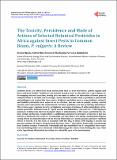| dc.description.abstract | Common beans are affected by many insect pests such as bean leaf beetle, aphids, legume pod
borer and bean beetles. Traditional and cultural practices such as site selection, crop rotation, intercropping
and seed selection, sowing date are used to reduce the infestation of insect pests of
common beans in the field and in storage rooms. Natural enemies such as predators, parasitoids
and pathogens can control the insect pests. Synthetic pesticides such as cypermethion, carbaryl,
and lambda-cyhalothrin have reported to be effective, but are toxic to people, destroy natural
enemies and contaminate the environment. Botanical pesticides are the promising alternatives.
This review paper explains toxicity, persistence and mode of actions of active ingredients of botanical
pesticides. Rotenone from T. vogelii has the oral lethal dose (LD50) of 132 - 1500 mg/kg to
mammals. It delays the electron transport chain in mitochondria of the insects and limits the cellular
energy production. Azadirachtin is antifeedant and growth disruptor of insects. It has low
toxicity to mammals. The oral LD50 in mammals is greater than 3540 mg/kg. Azadirachtin displays
strong effects on chemoreceptors of the insects. Pyrethrins are axonic poisons and have repellent
effects to insects. It is less toxic to mammals with the LD50 of about 1500 mg/Kg. It attacks the
nervous systems of insects. Sesquiterpene lactones from T. diversifolia, Pentacyclic triterpenoids
from Lantana camara, Vernodalin, Vernodalol and Epivernodalol from V. amygdalina have repellent
and feeding deterrents chemicals which discourage the insects from feeding the crop. Most
active ingredients of botanical pesticides have short life span in the environment. | en_US |

